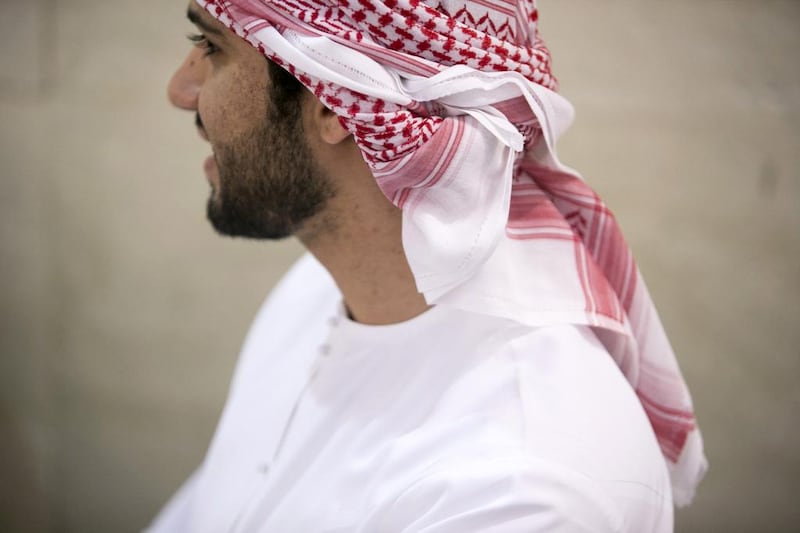Traditional fashion is ever changing. This is bad news for Mohammed Akram.
The tailor moved from Lahore, Pakistan, to Ras Al Khaimah in 1986 to open a sirwal workshop. The baggy cotton trousers worn under a woman’s traditional dress were such an indispensable part of the Emirati wardrobe that his business soon grew to three shops with 30 to 40 employees.
“There’s good money in culture,” says Mr Akram, 55. “It was all sirwal and dresses. There were no abayas.”
With the rise of the abaya, a black cloak that spread east from Saudi Arabia, young women swapped the sirwal for trousers and Mr Akram's business shrunk to one shop and 15 employees. He survives off ageing customers.
“Different, different, everything’s different,” the tailor says. “Girls don’t want it. They wear trousers, jeans, western fashion design. Only old women are wearing this, women over 50, 60. Before the sirwal was an Emirati style. Before, they didn’t know the styles in other countries or have an idea which they liked best.”
Now the sirwal has gone the way of the burqa, the burnished cloth mask worn over the brow and nose associated with women of a certain age.
“Maybe there’ll be no sirwals in another 20 years,” says Mr Akram. “The old will be gone and there will be only jeans and abayas left.”
Changing fashions are not only a concern for tailors.
This year the Federal National Council debated the need for a policy to protect national dress. The proposal by Ahmed Al Amash, a member from Ras Al Khaimah, warned that it was falling out of favour with the younger generation. Mr Al Amash called for action. The council could not accept "globalisation of principles" in matters of national dress and identity.
In response, Sheikh Nahyan bin Mubarak, the Minister of Culture, Youth and Community Development, said national dress was a source of pride for Emiratis, but agreed to order a broader study on national identity.
All of which raises the question, just what is national dress? Does it exist and, if so, how is it defined and according to what parameters?
“You can’t cast fashion in stone, even if it is called national dress,” says Dr Jane Bristol-Rhys, associate professor of anthropology at Zayed University. “It’s clothing that falls into the category of fashion and people will modify it to suit their tastes. They’ll make it work for them.”
During her 13 years in Abu Dhabi, Dr Bristol-Rhys’s research and teaching have focused on the history, heritage and material culture of the UAE. Her 2010 study Emirati Women: Generations of Change, used material gathered from interviews with three generations of Emirati women to paint a nuanced picture of their attitudes towards issues ranging from independence and marriage to freedom and the future.
“The life that the younger generation are living is very different from the life lived by their mothers,” Dr Bristol-Rhys explains. “Women in their twenties and thirties are modernising it. They’re using appliques, they’re using embroideries, they’re using shoulder pads – there are even abaya with brass spikes on the shoulders that look like they’ve come straight from a Wagnerian opera – all of which is a world away from the slipover, over-the-head abaya of the past.”
Young women say the abaya is “traditional Emirati”. Elderly Emirati women such as Umm Jassim, a sea captain’s wife born in Dubai, describe the abaya and the niqab veil covering as a “new” trend and recent import.
“It’s from outside the country, not here,” says Umm Jassim, who lives in Ras Al Khaimah. “Old women did not wear abaya, they wore the shayla and burqa. We didn’t have niqab. This came from Saudi.”
In her mother’s generation, women wore a colourful long-sleeved dress, sirwal bloomers and a sheer black veil. Her own generation wore an abaya draped from the head over the shoulder that grew more tailored over the decades. In the 21st century it became a statement of identity and independence.
The changes were subtle at first, black embroidery and modest rhinestones, but became bolder with each passing year: coloured embroidery, ribboned sleeves. Accessories also grew in size and importance, big sunglasses, big heels and big bouffant hair partly hidden by the shayla.
The embellishments are a sign of "resistance and deviation" within the confines of its long, black form, wrote Noor Al Qasimi in the Journal of Middle East Women's Studies.
Far from being the preserve of the younger generation, Dr Bristol-Rhys observes changing attitudes towards national dress across all generations
“There are women in their forties who have college degrees and are working and they’re wearing what works at work. They’re buying cheaper abaya because they want a different one every day because it drags on the ground and gets dirty.
“Then there are women who are now in their early fifties, who for years wore the burqa – at weddings and when they went out – and they are no longer doing that. The burqa seems suddenly out of fashion.”
For Dr Bristol-Rhys, the success of Emirati national dress rests in its ability to accommodate the shifting vagaries of fashion while remaining immediately recognisable for what it is, a fundamental expression of Emirati identity. It is the definition of a successful, living tradition. “Emirati heritage can’t be set in aspic. The minute you put heritage in a museum, mark it dead. Heritage and traditions live on only as long as they can be adapted and included in people’s changing lives,” the anthropologist explains.
“Things that have cultural value – like the idea of national dress – will carry on, but they will carry on changed because people’s lives change and they take forward things that they want to preserve and to honour into new forms. That’s true in every culture.”
Fashion also changed underneath the abaya. In the 1960s, women wore trousers with long shirts, so that the shape of their bottoms could not be seen. Today, it’s often skinny jeans and leggings.
Changes are not limited to women's fashion. The shape of a man's kandura has also grown more fitted in the past five years and now appears in seasonal colours of yellows, blues and browns popularised in the past decade. Designer kanduras have taken their place alongside abayas on the fashion catwalk.
“When a sheikh wears a colour, everyone else wants the same,” says Rajan Kanath Kariath Valappil, a tailor who has worked at Marhaba Gents Garments in Ras Al Khaimah since 1988. “A lot of people chose the colour based on what the sheikh wears.”
Discussion about dress often focuses on national identity. Collar styles are associated with country. Example include the Bahraini shirt collar, the Saudi Arabian two button collar and the Emirati collarless kandura with its long hanging tassel, or tarboosh.
The tarboosh was once a few centimetres long but is now commonly worn past the navel. Its length has grown with its identification as a national symbol that distinguishes the Emirati kandura from the gowns worn in other countries.
The style of a man’s headdress, or ghutra, is often associated with his country, though less strictly so. The “cobra”, a ghutra starched into a hooded style is commonly associated with Saudi Arabia, the free-flowing “teacher” style with the UAE.
Ahmed Al Mulla, 40, an Emirates National Oil Company employee from Dubai, says style distinguishes Emiratis. “Our national dress gives us a sense of belonging and uniqueness,” he says. “Kandura and abaya are going through a new transition to fit in the 21st century, but the national dress will not face extinction.”
In Oman it is obligatory to wear national dress in the public sector workplace, he says, and the UAE should follow suit. “I hope my country enforces a similar law so that we represent this country’s culture and values,” he says.
Even names change. Kandura, a word of Persian origin, is the current popularised term for the gown in the emirates, replacing the Arabic term dishdasha about 15 years ago. Dishdasha is still widely used in other Arabian Gulf countries.
With each generation, fashion is scrutinised according to changing national, religious and cultural norms.
Such debates are addressed in Abdulrahman Al Madani's 2012 documentary The Gamboo3a Revolution. The film documents reactions to the gamboo'a, a beehive or "camel hump" hair style worn under the shayla.
For the previous generation, women wearing tight trousers was unacceptable to many, even in all-female company.
When the film was made, the trend was already deemed old fashioned by its subjects.
“Maybe after a year or so, we’ll see things other than the gamboo’a,” said Maryam Al Ansari, a Zayed University digital technology officer interviewed in the documentary. “Maybe the gamboo’a would be a thing of the past. God knows what else will appear. Hopefully we won’t be shocked.”
azacharias@thenational.ae
nleech@thenational.ae
* Additional reporting by Asmaa Al Hameli






